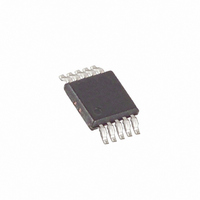MAX1108EUB+ Maxim Integrated Products, MAX1108EUB+ Datasheet - Page 17

MAX1108EUB+
Manufacturer Part Number
MAX1108EUB+
Description
IC ADC 8BIT LP 10-UMAX
Manufacturer
Maxim Integrated Products
Datasheet
1.MAX1109EUB.pdf
(20 pages)
Specifications of MAX1108EUB+
Number Of Bits
8
Sampling Rate (per Second)
50k
Data Interface
MICROWIRE™, QSPI™, Serial, SPI™
Number Of Converters
1
Power Dissipation (max)
444mW
Voltage Supply Source
Single Supply
Operating Temperature
-40°C ~ 85°C
Mounting Type
Surface Mount
Package / Case
10-MSOP, Micro10™, 10-uMAX, 10-uSOP
Number Of Adc Inputs
2
Architecture
SAR
Conversion Rate
50 KSPs
Resolution
8 bit
Interface Type
Serial
Voltage Reference
Internal 2.048 V or External
Supply Voltage (max)
3.3 V
Mounting Style
SMD/SMT
Lead Free Status / RoHS Status
Lead free / RoHS Compliant
In external clock mode, if CS is toggled before the cur-
rent conversion is complete, the current conversion is
terminated, and the next high bit clocked into DIN is
recognized as a new start bit. This can be useful in
extending acquisition time by selecting conversion on
the same channel with the second control byte (double-
clocking mode), effectively extending acquisition to 6
SCLKs. This technique is ideal if the analog input
source has high impedance, or if it requires more than
1µs to settle; it can also be used to allow the device
and the reference to settle when using power down-
modes (see Power-Down Modes section).
This mode of operation samples and converts the mid-
supply voltage, V
Set SEL2 = SEL1 = SEL0 = 0 in the control byte to
select this configuration. This allows the user to monitor
the condition of a battery providing V
voltage must be larger than V
operation to work properly. From the result of conver-
sion (CODE), V
V
When power is first applied, the MAX1108/MAX1109’s
reference is powered down and SHDN is not enabled.
The device needs to be configured by setting CS low
and writing the control byte. Conversion can be started
within 20µs if an external reference is used. When using
the internal reference, allow 12ms for the reference to
settle. This is done by first performing a configuration
conversion to power up the reference and then perform-
ing a second conversion once the reference is settled. No
conversions should be considered correct until the refer-
ence voltage (internal or external) has stabilized.
To save power, place the converter into low-current
power-down mode between conversions. Minimum
power consumption is achieved by programming
REFSHDN = 0 and SHDN = 0 in the input control byte
(Table 4). When software power-down is asserted, it
becomes effective only after the conversion. If the con-
trol byte contains REFSHDN = 0, then the reference will
turn off at the end of conversion. If SHDN = 0, then the
chip will power-down at the end of conversion (in this
mode I/EREF or REFSHDN should also be set to zero).
Table 4 lists the power-down modes of the MAX1108/
MAX1109.
__________Applications Information
DD
= CODE · V
REF
DD
______________________________________________________________________________________
DD
/ 128.
/ 2, which is internally generated.
Battery Monitoring Mode
is determined as follows:
Power-On Configuration
Power-Down Modes
DD
/ 2 for this mode of
DD
. The reference
2-Channel, Serial 8-Bit ADCs
Single-Supply, Low-Power,
The first logical 1 clocked into DIN after CS falls powers
up the MAX1108/MAX1109 (20µs required for the
device to power up). The reference is powered up only
if internal reference was selected during the previous
conversion. When the reference is powered up after
being disabled, consider the settling time before using
the result of conversion. Typically, 12ms are required
for the reference to settle from a discharge state; less
time may be considered if the external capacitor is not
discharged completely when exiting shutdown. In all
power-down modes, the interface remains active and
conversion results may be read. Use the double clock-
ing technique described in the Data Framing section to
allow more time for the reference to settle before start-
ing a conversion after short power-down.
The MAX1108/MAX1109 operate from a single supply
and feature a software-controlled internal reference of
+2.048V (MAX1108) and +4.096V (MAX1109). The
device can operate with either the internal reference or
an external reference applied at the REF pin. See the
Power-Down Modes and Modes of Operation sections
for detailed instructions on reference configuration.
The reference voltage determines the full-scale range:
in unipolar mode, the input range is from 0 to V
bipolar mode, the input range spans RI ±V
RI = V
Table 4. Power-Down Modes of the
MAX1108/MAX1109
X = Don’t care
I/EREF
1
1
0
1
0
1
CONTROL BYTE
REF
BIT 2–BIT 0 OF
REFSHDN
/ 2.
X
X
1
0
0
1
SHDN
1
1
1
0
0
0
Device Active/Internal
Reference Active
Device Active; Internal refer-
ence powered down after con-
version, powered up at next
start bit.
Device Active/External
Reference Mode
Device and internal reference
powered down after conversion,
powered up at next start bit.
Device powered down after
each conversion, powered up
at next start bit. External
Reference Mode.
Reserved. Do not use.
Voltage Reference
OPERATING MODE
REF
/ 2 with
REF
; in
17











